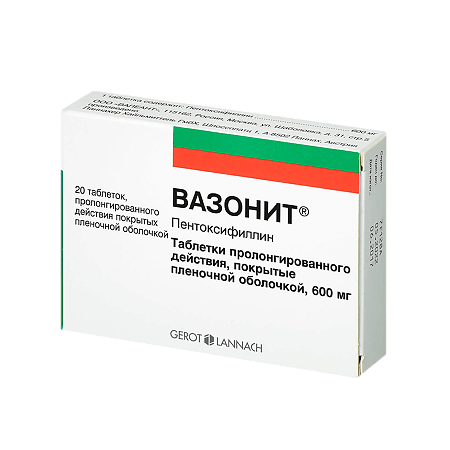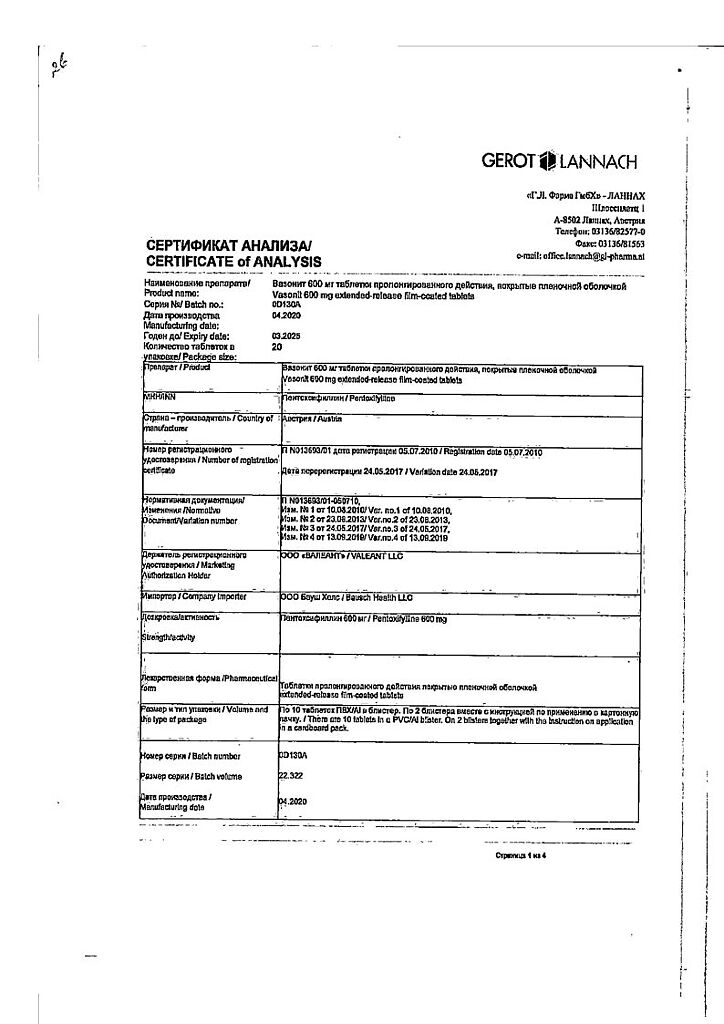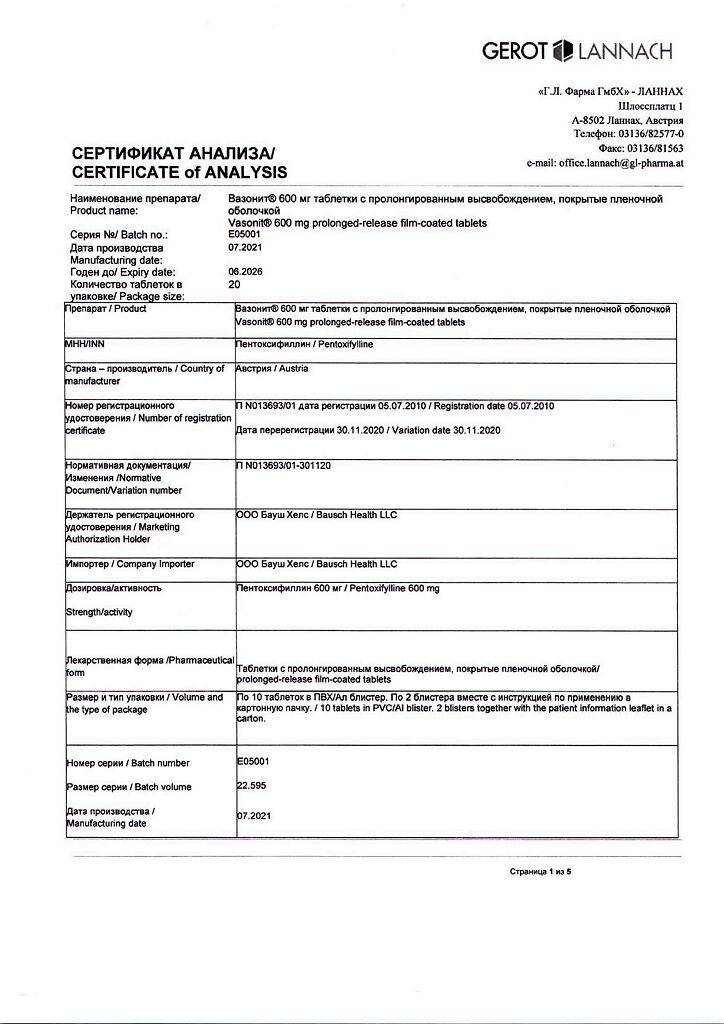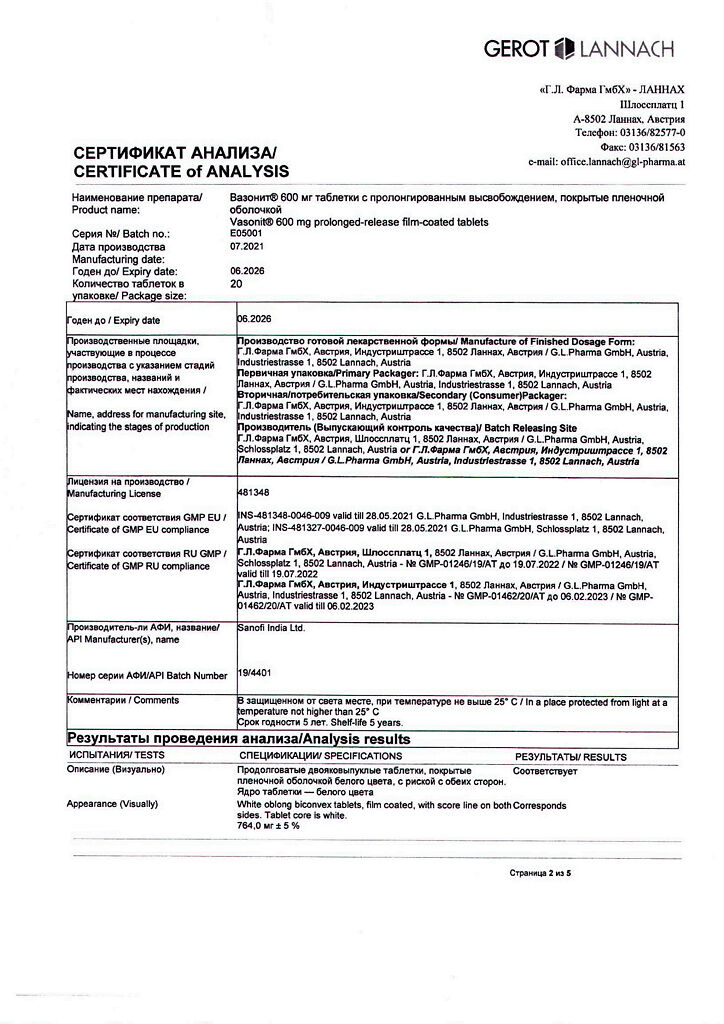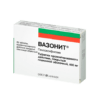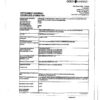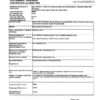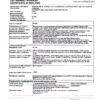No products in the cart.
Vasonit, 600 mg 20 pcs.
€15.32 €12.76
Description
Pharmaceutical group:
Vasodilator.
Pharmaceutical action:
Vasonit is a xanthine derivative. It improves the microcirculation in areas of poor blood supply. It improves rheological properties of blood (fluidity) due to influence on pathologically changed deformability of erythrocytes; it increases elasticity of erythrocyte membranes, inhibits erythrocyte and platelet aggregation and decreases increased blood viscosity.
The mechanism of action of the drug is associated with inhibition of phosphodiesterase and accumulation of CAMF in vascular smooth muscle cells and in blood cells. Pentoxifylline inhibits platelet and erythrocyte aggregation, reduces plasma levels of fibrinogen and enhances fibrinolysis, which leads to a decrease in blood viscosity and improvement of its rheological properties.
It improves the supply of tissues with oxygen in areas of impaired blood circulation (including in the limbs, CNS and, to a lesser extent, the kidneys). With occlusive lesions of the peripheral arteries (intermittent claudication) leads to an increase in walking distance, elimination of night cramps, calf muscles, reduction of pain at rest.
In case of impaired cerebral circulation improves symptoms. It has a weak myotropic vasodilator effect, slightly decreases RPS and slightly dilates coronary vessels.
Indications
Indications
Blood circulation disorders in: Atherosclerosis, Diabetes, Raynaud’s disease;
The treatment of trophic ulcers,the treatment of cerebral circulatory disorders.
Active ingredient
Active ingredient
Composition
Composition
1 tablet contains:
Active substance:
pentoxifylline 600 mg;
Supplementary substances:
Hypromellose 15000 mPa*s,
Microcrystalline cellulose,
Crospovidone,
Colloidal silicon dioxide,
Magnesium stearate;
Shell composition:
Macrogol 6000,
Hypromellose 5 mPa*s,
Silicon antifoaming agent SE2 MK,
titanium dioxide,
talc,
Polyacrylate dispersion 30%.
How to take, the dosage
How to take, the dosage
The enteric-coated tablets are swallowed whole with a small amount of water.
The daily dose is divided into 3 doses. The initial dose is 600 mg/day.
The dose can be reduced to 300 mg/day as the condition improves.
The prolonged dosage forms are prescribed 2-3 times a day.
Interaction
Interaction
Pentoxifylline may increase the effect of drugs that affect the blood coagulation system (indirect and direct anticoagulants, thrombolytics), anitibiotics (including cephalosporins – cefamandole, cefaperazone, cefotetan), valproic acid.
Induces the effectiveness of hypotensive drugs, insulin and oral hypoglycemic drugs. Cimetidine increases the plasma concentration of pentoxifylline (risk of side effects).
The co-administration with other xanthines may lead to excessive agitation of patients.
Special Instructions
Special Instructions
The treatment should be carried out under control of BP. In patients with diabetes mellitus taking hypoglycemic drugs, administration in high doses may cause significant hypoglycemia (dose adjustment is required).
When prescribing concomitantly with anticoagulants, the parameters of the blood coagulation system should be closely monitored. In patients who have recently undergone surgery, systematic monitoring of Hb and hematocrit is necessary.
The administered dose should be reduced in patients with low and unstable BP. In the elderly, a dose reduction may be required (increased bioavailability and decreased excretion rate).
The safety and efficacy of pentoxifylline in children have not been adequately studied. Tobacco smoke may reduce the therapeutic effectiveness of the drug. Compatibility of pentoxifylline solution with infusion solution should be checked on a case-by-case basis.
Contraindications
Contraindications
Side effects
Side effects
The digestive system: possibly – nausea, vomiting, diarrhea, dry mouth, decreased appetite, a feeling of overflow in the stomach, epigastric pain, increased activity of liver enzymes (ALT, AST, LDH) and ALP, cholecystitis, hepatitis, jaundice; rarely – bad taste in the mouth, hyper salivation.
CNS disorders: relatively rarely – headache, dizziness, anxiety, sleep disorders, seizures.
Sensory organs: rarely – conjunctivitis, scotoma, blurred vision, pain in the ear.
Cardiovascular system disorders: when using the drug in high doses, decreased blood pressure, tachycardia, angina pectoris, abnormal heart rhythm, flushing of the face, blood “rushes” to the face and upper chest, edema are possible.
Allergic reactions: probably – itching, skin rash, urticaria, Quincke’s edema; rarely – anaphylactic shock.
Hematopoiesis and hemostasis: rarely – bleeding (from the stomach, intestines, skin and mucous membranes), thrombocytopenia, leukopenia, pancytopenia, hypofibrinogenemia, changes in peripheral blood count, aplastic anemia. Because of this it is necessary to conduct regular monitoring of blood picture.
Others: rarely – malaise, increased nail fragility, weight changes, nasal congestion.
Overdose
Overdose
Symptoms: nausea, dizziness, decreased blood pressure, increased body temperature (chills), tachycardia, drowsiness or agitation, loss of consciousness, areflexia, possible tonic-clonic convulsions, “coffee grounds” vomiting (as a sign of gastrointestinal bleeding), arrhythmias.
Treatment: gastric lavage, subsequent symptomatic therapy. There is no specific antidote. In case of vomiting with traces of blood, gastric lavage is unacceptable.
Pregnancy use
Pregnancy use
The use of the drug Vazonit during pregnancy is contraindicated.
If it is necessary to use the drug during lactation, breastfeeding should be stopped.
Similarities
Similarities
Additional information
| Shelf life | 5 years |
|---|---|
| Conditions of storage | In a light-protected place, at a temperature not exceeding 25 °C |
| Manufacturer | G.L. Pharma GmbH, Austria |
| Medication form | sustained release tablets |
| Brand | G.L. Pharma GmbH |
Related products
Buy Vasonit, 600 mg 20 pcs. with delivery to USA, UK, Europe and over 120 other countries.

